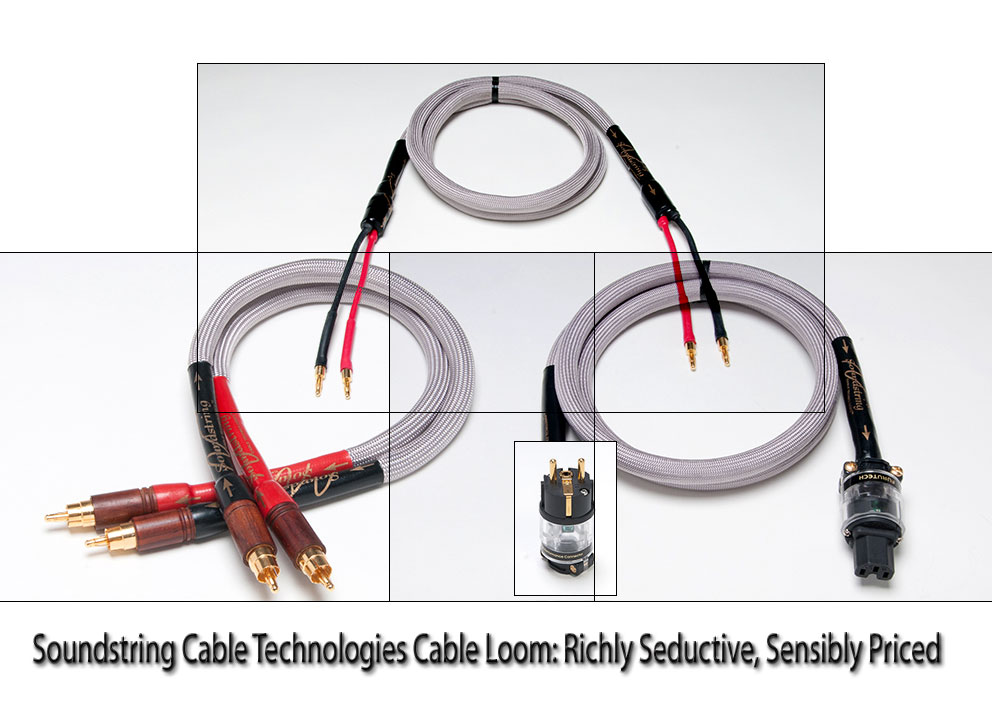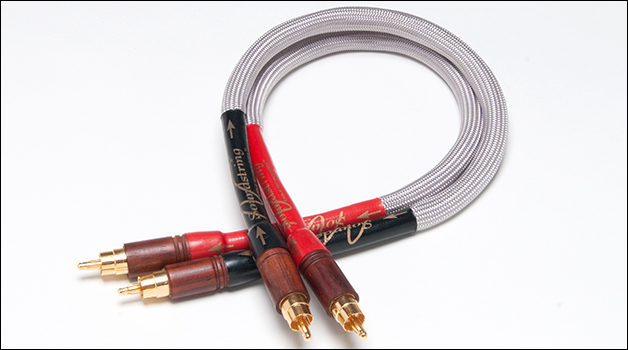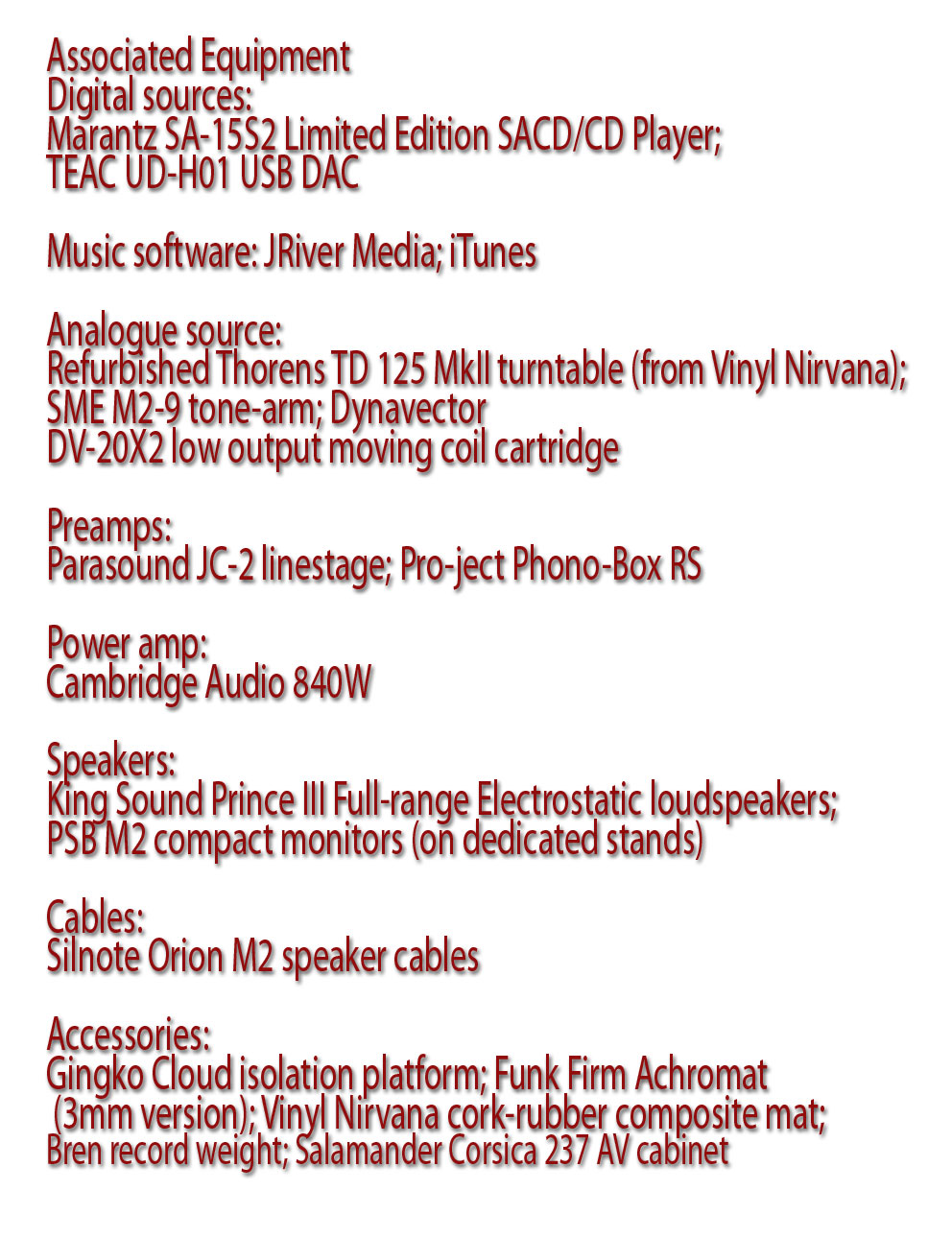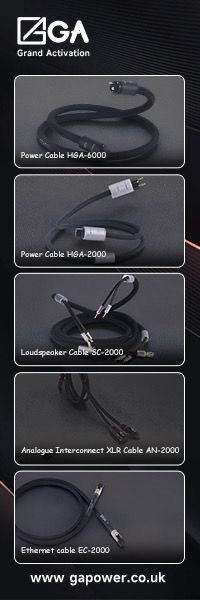Sound String Cable Techologies Gen II

Old firms, new wires
With little fanfare and even less advertising, Soundstring Cable Technologies, LLC™ has gone from a relatively new player in the high end cable universe in 2001 (more below) to a manufacturer of highly refined power cords, interconnects and speaker cables. And while the company may not be as familiar to some readers as high profile players like AudioQuest, Nordost and Kimber Kable, the firm’s beautifully engineered products certainly deserve a place on the short list of anyone considering a sensible, cost-effective cable upgrade that offers near reference level performance.
For this review I listened to a full loom of the firm’s GEN II Platinum Series and top-of-the-line GEN II Platinum Series SE power cords, interconnects (XLR and RCA terminated), and speaker cables. All Soundstring GEN II-level cables feature beautifully-textured woven platinum silver covers and extremely high quality plugs, connectors, and (for my speakers) spades. The power cords feature highly regarded plugs from Furutech. The balanced interconnects feature Neutrik XLRs, while the RCA interconnects employ gorgeous coca-bola wood housings. I’m not entirely sure how the wood housings impact overall sound quality, but they sure look great and add to pride of ownership. Speaker terminations are gold-plated. Overall build quality, appearance, and installation flexibility are excellent.
Founded in 2001, today’s Soundstring interestingly began as a merger of two established firms: Superior Insulated Wire Corporation and the Lion Cords Division of Astrophonic Corporation of America, “both manufacturers of a wide variety of insulated wires, cables and power supply cord products.” Soundstring’s comprehensive website notes that “[b]oth companies were independently founded in the mid 1940’s”, long before the dawn of the high fidelity era.
What does this brief detour through pre-high fidelity history mean for music lovers? First, with decades of experience designing, engineering and selling cables worldwide, the company possesses a comprehensive understanding of the in and outs of high-quality, large-scale manufacturing and the use of various raw materials to maximize cable performance at affordable prices. The Soundstring name may not be widely known in some high end circles (it certainly deserves to be), but the firm has, in its various guises, been around about as long as McIntosh Labs (with over 140 years of combined business experience). Not many high end manufacturers can boast such longevity.
Second, the firm doesn’t just assemble components supplied by other manufacturers. Yes, Soundstring does use some components sourced from other companies – like the lovely Furutech plugs featured in its extensive range of power chords – but testing, engineering, design, extruding, shielding, molding, jacketing, cutting, stripping, etc., all occur in the firm’s South Norwalk, CT factory. While such an integrated approach to product design and manufacturing does not guarantee product quality and longevity, in my experience, this approach is more likely to deliver long-term customer enjoyment and satisfaction than simply cobbling together components ordered online from third-party suppliers and praying for the best.
Technical hi-lights
I won’t waste time exhaustively detailing all of the technical features that make these cables special. I refer you instead to Soundstring’s well-organized webpage and its thoughtfully presented 2015 White Paper. Let me here simply reference some of the hi-lights that Soundstring President Len Miller shared with me in a series of informative email exchanges that took place before I settled down to do some serious listening.

Two key features differentiate the standard GEN II Platinum Series cables from their tonier GEN II Platinum Series SE siblings. In Len’s own words, “[t]he “SE” cables all have enhanced conductor constructions with more strands per conductor plus a very special proprietary non-metallic 98% braided shield applied over each of the cable jackets before the platinum silver outer covering is put on. This proprietary non-metallic shield is inexpensive compared to a standard metallic shield, it is lightweight and it is very flexible. It acts as a barrier against potential outside RFI/EMI interference and enhances overall cable performance, all at a very low additional cost to the total cost of each cable type. It is used with all power cords, all speaker cables and the shielded and balanced interconnect cables. It is not available at this time with the single ended I/Cs, either shielded or unshielded. That is because the addition of the enhanced conductor sizes and non-metallic braided shield increases the outside diameter of these cables and does not allow the coca-bola wood housings on the RCA plugs to fit over the larger diameter. We are trying to find a source for the larger diameter coca-bola wood dowel that can be milled out to accommodate the larger cable diameter. Until that is accomplished, we cannot supply these two interconnect cable types in the new “SE” construction.”
____________
[1] I suggest that you also read Dave Thomas’s 2014 review of the GEN II Platinum Series cables for additional design and system integration details.
To a large degree, my listening experiences with the GEN II and GEN II SE lines echoed the differences hi-lighted in Len’s technical description. As fine as the Soundstring GEN II cables sounded, the GEN II SEs offered bigger, bolder sonics, with crisper dynamics, and paradoxically, a more relaxed, natural presentation overall. The tonal balance with both sets of cables – while essentially neutral – tended at times toward the slightly warmer end of the spectrum, with the SEs sounding that little bit more neutral, balanced, and airy on top. Overall performance gains with the GEN II Platinum Series SEs easily justified their price premium.
As far as materials selection goes, Soundstring eschews silver wires in favor of high performance, high quality oxygen free, high conductivity copper because copper offers what the company sees as the best price to performance ratio, along with greater ease of use, greater physical flexibility, and easier system integration.
When I raised the issue of choosing between shielded and unshielded RCA interconnects, Len was equally forthright and knowledgeable: “Shielding can only take away from cable performance, not add to it. The shielded interconnects we have with RCAs are only meant to be used in extreme situations where there is a turntable in use with a magnetic cartridge, where there may be system components that give off RFI or EMI, if you are in close proximity to a cell tower, airport or industrial park where RFI or EMI could affect system performance, or if the electrical circuitry your sound system is plugged into also has other electronic or electrical products in use that might affect the flow of voltage or introduce RFI or EMI into the circuit in some way. The use of unshielded cables wherever possible will give you a more open and transparent quality of sound reproduction that shielded cables just cannot duplicate.”
As added value, Soundstring “burns” all of their cables prior to shipment, good news for impatient audiophiles who want to hear how their new toys sound instantly (well almost), not three weeks (or even months) later. The company uses Arizona-based Audio Excellence AZ’s Audiodharma Cable Cooker to “pre-condition” complete cables for a minimum of 120 hours. Soundstring recommends an additional 24 to 48 hours of in-system “cooking” to permit the cables to settle into the listener’s system/home listening environment. For my part, I didn’t detect a big difference in sound quality immediately after I installed the cables versus the sound several days later, which attests to the effectiveness of the pre-shipping burn-in process.
Sonic impressions
All cables boast sonic signatures of varying degrees, some a bit more than others. The Soundstring cables did not deviate from this norm. Fresh out of the box, they delivered a big, bold, richly balanced presentation that sounded almost Technicolor in their tonal saturation and exuberance. By Technicolor, I refer of course to the deeply saturated color palates that would become the visual hallmark of those mid to late 1950s films that used the innovative three-strip color encoding process to remarkable effect. Anyone who has marveled at the spectacular range of hues founds in films like Ben Hur, the Wizard of Oz, or the Ten Commandments knows whereof I speak.

The Soundstring loom reproduced the full aural color spectrum with something approaching the intensity, depth of saturation, and vibrancy of its visual Technicolor counterpart. Coming on the heels of the airy, pepperminty-balanced Audiocadabra interconnects and speaker cables, the Soundstring loom sounded considerably richer tonally. Some might describe the sound as a touch dark in character, especially when describing the speaker cables, and I would not care to argue that assessment.
By “dark” I do not mean bass-heavy, dynamically closed-in, or frequency constricted (especially up top), what some reviewers might describe as a “grayish” taint. Nor do I mean to suggest (or imply), that the Soundstring loom departs from overall neutrality to any significant degree. Rather, by “dark” I mean to suggest that the cables sound as if tonally weighted from the bottom up. Bass notes have a depth, a gravitas, a sheer heft if you will, that sounds positively marmoreal. This added sense of gravitas results in a fuller, bigger, bolder and more dramatic presentation than that captured by the lighter-balanced Audiocadabras.
To put things into perspective, I don’t think that the Audiocadabra cables were passing on more high frequency content per se to the speakers. Rather, the Indian cable’s subtle but noticeable tilt upward, coupled with their mild but distinct leanness in the power range, meant that higher frequency musical content stood out more prominently in the overall mix. By the same token, the Soundstring loom, because of its fuller, richer (darker if you will) balance meant that high frequency content came across as a bit more subtly woven into the overall sonic fabric.
_________
[1] In his earlier review (which I deliberately avoided reading until I had finished my own extended listening evaluations), our own Dave Thomas detected what he thought was perhaps a touch of congestion in the GEN II cable’s lower registers when pushed to dynamic extremes. I never detected any congestion in that range during my listening sessions, but neither of the speakers that I have in-house, not the PSB M2s nor the King Sound Prince IIIs, dig as deeply or play as loudly as the Escalante Design Fremonts or the Black Moon Audio Fidelity Ones used in his review. I suspect that the PSBs can match the big Maggie MG 20s that Dave also uses in the loudness department, but can’t dig as deeply into the bass region. The bass of the King Sound Prince IIIs, despite their superb clarity and transparency, only goes down to about 45Hz in my listening room, maybe a touch lower. Moreover, they are highly inefficient devices, limiting their overall loudness capabilities.
 The Soundstring bundle reproduced music’s power range – the frequency range that dips to about 150hz and extends up to about 350hz – in all its glory. Well-recorded classical fare retained its natural weight and power, allowing one to hear why SACD remains the preferred recording format for many labels. Conductor Marc Albrecht’s superb reading of Charles Koechlin’s Les Bandor-log from the composer’s Jungle Book orchestral tone poem (on Dukas-Ravel-Koechlin-Albrecht [PentaTone Classics, PTC 5186-336]) bristles with dynamic energy. The power range features prominently throughout the work. The Soundstrings conveyed the full weight of the orchestra – the lower strings, brass and tympani in particular – without smearing and without the sense of ponderous thickening that lesser devices sometimes impart.
The Soundstring bundle reproduced music’s power range – the frequency range that dips to about 150hz and extends up to about 350hz – in all its glory. Well-recorded classical fare retained its natural weight and power, allowing one to hear why SACD remains the preferred recording format for many labels. Conductor Marc Albrecht’s superb reading of Charles Koechlin’s Les Bandor-log from the composer’s Jungle Book orchestral tone poem (on Dukas-Ravel-Koechlin-Albrecht [PentaTone Classics, PTC 5186-336]) bristles with dynamic energy. The power range features prominently throughout the work. The Soundstrings conveyed the full weight of the orchestra – the lower strings, brass and tympani in particular – without smearing and without the sense of ponderous thickening that lesser devices sometimes impart.
The Soundstrings delivered very nearly the same tonal and dynamic verisimilitude further up the frequency spectrum (the GEN II SEs offering that little bit more in terms of overall resolution, power and depth). At about minute 2:14, when the rambunctious monkey tribe captures young Mowgli and attempts to make the boy-wolf one of their own, all hell breaks loose. Hi-lighting the chaos, the flutes take up a darting, playful series of 16th note runs, a theme later reiterated by piano and strings. Koechlin intended this theme to denote the chaotic, incomprehensible gibberish (bandor-log) that the monkey-tribe considered language. Conductor Albrecht and his Strasbourg Philharmonic stalwarts capture the chaos brilliantly. The whole effect is at once maddening and amusing, with solo instruments and instrumental clusters darting in and out of the sonic picture for no apparent reason other than to be heard.
Koechlin calls on every instrument in the orchestra to join in the romp, with noteworthy bassoon, xylophone, and harpsichord solos adding touches of lavender, hints of orange, and bursts of purple to the rambunctious aural finger-painting workshop. It’s all great fun, at times brooding and sinister, at others jazzy and free-spirited, and a great test of any given system’s ability to reproduce accurately the full spectrum of orchestral tone colors. The Soundstring GEN IIs (both regular and SE versions) passed this test with flying colors.
And just when I thought that SACD’s inherent tonal signature involved the subtle rolling-off of high frequencies (my hearing tops off a about 17.5 kHz, in case anyone is interested), the Soundstring loom (especially with the superb King Sound Prince III full range electrostatic speakers in the mix – review forthcoming) revealed that the best SACDs (like the PentaTone disc) can indeed sound airy and lit-from-within, if not ultimately to the same degree as the best analog recordings.
Mixing and matching
As much as I loved the added touch of richness the Soundstring loom delivered, some listeners might consider their whole milk balance too much of a good thing. This was especially true with the GEN II and GEN II SE speakers cables woven into the mix. This wasn’t so much a problem as a notable shifting of the overall tonal balance toward the bass region in my system. In systems that already lean toward the warm, forgiving side of the tonal spectrum, the complete Soundstring package might deliver a bit too much richness. With the PSB compacts, for example, the sound was perhaps a tad warmer than I typically prefer. To my surprise – and a testament to their resolving power – the Soundstrings revealed a subtle darkness in the overall weighting of the PSBs that had previously escaped me. With the leaner King Sound panels, the Soundstring mix sounded superb overall with spot-on neutrality. Again, the key here is to find the right mix of components in any given system. There is no perfect “one size fits all” prescription.
Toward the end of this review, I received a sampling of cables from Virginia-based Silnote Audio. Curious to hear how the Soundstring cables would fare in the presence of the much more expensive Silnote Orion M2 speaker cables (priced at approximately $3,300 for a 3 meter pair), I replaced the GEN II SEs with the M2s. While seemingly priced out of line with the more affordable Soundstrings, the mating of the Orion M2s with the Soundstring interconnect/power cable loom produced (with both the PSBs and the King Sounds) the best sound I have ever heard in my system. The rich, full-bodied (but not overly so) tonal balance that I prefer was mated to a transient quickness, an eerie level of detail retrieval, and an openness and airiness that were truly world class.
To contextualize yet again, the Soundstring GEN II SE speaker cables offered 90% (if not more) of the sound quality of the pricier Orion M2s at roughly one sixth the price. What the additional funds buy are subtle but musically important gains in resolution, smoothness and openness. By the same token, I could happily live with the full Soundstring loom and never hanker for something subtly better. Taken another way, one could invest in a complete Soundstring loom today and get truly great sound (a roughly $3k to $4K proposition). As funds permit, one can add something like the pricier Silnote Orion M2s and discover that the remaining Soundstrings are fully capable of keeping up with the (significantly) more expensive addition.
This makes the Soundstrings an ideal choice for music lovers who have invested $15K to $20K (or more) in their systems (minus cabling) and seek wires that can compete head-on with the rest of their components, but also remain viable foundational choices when “upgraditis” rears its head. For music lovers staring college tuitions, car and mortgage payments, and pending retirements in the face, the Soundstring looms represent sensible final purchase options for which no apologies need be made.
Wrap-up
As I commit final thoughts on the Soundstrings to paper, I cue up a new CD purchase (Sinne Eeg’s 2010 release Don’t Be So Blue [Red Dot Music – RDM 010]) to determine whether and to what extent female voice will receive the same care as did full-blown orchestral fair. The complete Soundstring loom does not disappoint. The Danish jazz diva moves and mesmerizes in equal measure as she mournfully plunges into the depths of unrequited love, denial, and ultimately, despair on the superb “The Writing on the Wall”. Morten Toftgård Ramsbøl’s acoustic bass digs deep, its woody, oaky overtones and transient plucks naturally articulated, its hauntingly sweet timbre soulfully rendered. Piano, bass, and drums are all reproduced with plenty of transient snap and superb overall focus, each instrument surrounded by a billowy cushion of ambient air. Soundstage cues appear as if literally plucked out of the ether.
It doesn’t get much better than this! Enthusiastically recommended.
maurice jeffries

Maurice Jefferies
Pricing and distribution update
Just as I finished this review, I got an email from Len Miller informing me that Soundstring had adopted a brand new distribution and pricing model. The old model assumed that purchasers would acquire their cable(s) of choice from Soundstring’s established network of domestic and global dealers and distributors. The old pricing structure factored in estimated dealer costs plus the traditional dealer profit up-charge. As of this writing, Soundstring will now distribute its extensive line of cables direct-to-consumers via an online (e-commerce) sales platform, much like those used by eBay and Amazon.
______
[1] Refreshingly, Soundstring’s Len Miller’s completely avoided making silly, boastful claims about his firm’s excellent product line. Instead, Len stated, and quite accurately in my estimation, that the complete Soundstring loom can go toe-to-toe with some of the best the industry has to offer – and at a far more attractive price – if not actually exceeding the performance of costlier ne plus ultra wires.
According to Len, the rapid increase in domestic online sales and sales of low cost cables from overseas providers prompted the change. Because many of these newer entrants have little in the way of administrative overhead, and little if any R&D, manufacturing, and labor costs (except their own time and the cost of securing necessary parts and materials), they can sell their wares at extremely low prices. According to Len, this has led to a “muddling of the market” so to speak. He also noted that “[o]nly a few of the older, high performance cable companies with worldwide name recognition like Kimber Kable, Nordost and AudioQuest are still able to sell through dealers at premium prices.”
Hence, Soundstring’s new sales model and lower pricing structure, something that should come as welcome relief for those reader’s with strained pocketbooks. This means that one can now obtain a complete Soundstring loom (minus digital and phono cables) for an outlay of only $3K to $4K. Prior to the pricing change it would have cost roughly $6K to $8K to put together the same package. As with any online purchase, the only practical downside remains, of course, the inability to audition these cables first before shelling out your hard-earned clams. However, Len informed me that Soundstring will sell its cables on a 30 day demo basis to anyone requesting those terms of sale. Customers must pay for the cables at the current e-commerce cost, plus shipping, insurance, handling and any processing fees that credit card issuers or bank wire transfer service providers might assess.
Stereo Times will provide additional updates as they become available.
Soundstring model and price guide (one year manufacturer’s warranty on all cables):
Current Retail Pricing on Popular Standard Catalog Lengths:
GEN II 30 AMP HIGH OUT-PUT POWER CORDS
Catalog Number Length Old Retail Price Ea. New Retail Pricing
SS-GEN II-PC30-FMF-3-US 3 Feet $ 600.00 $ 320.00
SS-GEN II-PC30-FMF-6-US 6 Feet $ 640.00 $ 355.00
SS-GEN II-PC30-FMF-8-US 8 Feet $ 680.00 $ 375.00
SS-GEN II-PC30-FMF-10-US 10 Feet $ 720.00 $ 395.00
GEN II 10 AMP LOW OUT-PUT DIGITAL POWER CORDS
Catalog Number Length Old Retail Price Ea. New Retail Pricing
SS-GEN II-PCLOD10-FMF-3-US 3 Feet $ 510.00 $ 275.00
SS-GEN II-PCLOD10-FMF-4-US 4 Feet $ 520.00 $ 280.00
SS-GEN II-PCLOD10-FMF-6-US 6 Feet $ 540.00 $ 295.00
SS-GEN II-PCLOD10-FMF-8-US 8 Feet $ 580.00 $ 310.00
GEN II NON-SHIELDED AND SINGLE ENDED INTERCONNECT CABLES
Catalog Number Length Old Retail Price Pr. New Retail Pricing
SS-GEN II-ICNS- 3-RCA 3 Feet $ 510.00 $ 200.00
SS-GEN II-ICNS- 6-RCA 6 Feet $ 570.00 $ 230.00
SS-GEN II-ICNS-10-RCA 10 Feet $ 690.00 $ 280.00
GEN II SHIELDED AND SINGLE ENDED INTERCONNECT CABLES
Catalog Number Length Old Retail Price Pr. New Retail Pricing
SS-GEN II-IC95- 3-RCA 3 Feet $ 540.00 $ 220.00
SS-GEN II-IC95- 6-RCA 6 Feet $ 600.00 $ 250.00
SS-GEN II-IC95-10-RCA 10 Feet $ 740.00 $ 305.00
GEN II SHIELDED AND BALANCED INTERCONNECT CABLES
Catalog Number Length Old Retail Price Pr. New Retail Pricing
SS-GEN II-IC95- 3-XLR 3 Feet $ 440.00 $ 170.00
SS-GEN II-IC95- 6-XLR 6 Feet $ 500.00 $ 210.00
SS-GEN II-IC95-10-XLR 10 Feet $ 640.00 $ 265.00
Manufacturer contact information
Soundstring Cable Technologies, LLC
149 Woodward Avenue
South Norwalk, CT 06854-4798
Office: 203-853-9300
website: www.soundstringcable.com
Stereo Times Masthead
Publisher/Founder
Clement Perry
Editor
Dave Thomas
Senior Editors
Frank Alles, Mike Girardi, Russell Lichter, Terry London, Moreno Mitchell, Paul Szabady, Bill Wells, Mike Wright, and Stephen Yan,
Current Contributors
David Abramson, Tim Barrall, Dave Allison, Ron Cook, Lewis Dardick, John Hoffman, Dan Secula, Don Shaulis, Greg Simmons, Eric Teh, Greg Voth, Richard Willie, Ed Van Winkle, Rob Dockery, Richard Doron, and Daveed Turek
Site Management Clement Perry
Ad Designer: Martin Perry





Be the first to comment on: Sound String Cable Techologies Gen II